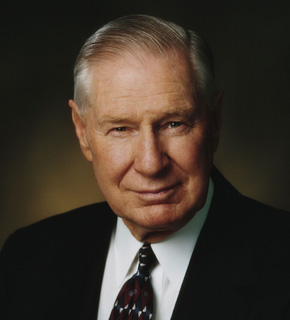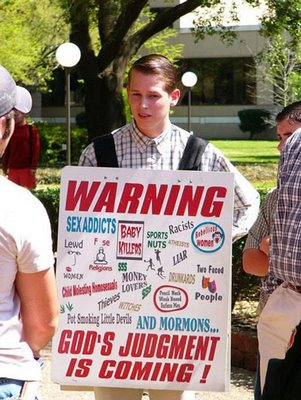[UPDATED 01/27/08 2125 MST]
This entry is suddenly getting a lot of hits, due undoubtedly to the death earlier today of Pres. Gordon B. Hinckley. With the death of Pres. Hinckley, the First Presidency of the Church of Jesus Christ of Latter-day Saints has been dissolved; Pres. Thomas S. Monson and Pres. Henry B. Eyring return to the Council of the Twelve Apostles (which now actually has 14 apostles in it); and Pres. Monson resumes his role as President of the Quorum of the Twelve, taking over from Pres. Boyd K. Packer, who has been serving as Acting President of the Twelve.
The Quorum of the Twelve, under the leadership of Pres. Monson, now leads the LDS Church. At some point, most likely within the next week or two, the Quorum of the Twelve will move to reorganize the First Presidency, with Pres. Thomas S. Monson as President of the Church, along with two counselors of his choosing. There’s a good chance (based on tradition) that Pres. Monson will retain Elder Eyring as one of his counselors, but that’s Pres. Monson’s choice, not a requirement.
Also note that this means that a new member of the Quorum of the Twelve will be called, though possibly not until the LDS General Conference in April.
[UPDATED 10/06/07 1034 MDT – Elder Henry B. Eyring has been called and sustained as 2nd Counselor in the First Presidency, while Elder Quentin L. Cook has been called to the Quorum of the Twelve. See here.]
==================== [ORIGINAL POST] ==============================
Peggy Fletcher Stack over in the Salt Lake Tribune writes about the “wild speculation” (her phrase, not mine) regarding whom Pres. Hinckley will call to replace Pres. Faust as 2nd Counselor in the First Presidency. First, in my own experience, the speculation tends to be tame rather than wild, though (in fairness) it’s probably a bit more of a topic of discussion within Utah than outside of it. Second, Stack gives no substantive basis for the specific candidates she mentions; one could as easily list all of the members of the Quorum of the Twelve instead of the few she picks out. Stack does correctly note that counselors have on occasion been chosen from outside of the Quorum of the Twelve, though it’s been roughly half a century since that happened. However, she incorrectly states that the calling as a counselor in the First Presidency is a “lifetime calling”; when the President of the Church dies, his counselors are automatically released and revert back to their positions in (or outside of) the Quorum of the Twelve, and the new President of the Church is free to select whomever he wants as counselors. (I sent Peggy a note on this, and she replied that she inadvertently left out a conditional phrase; easy enough to do with deadlines.)
Those minor quibbles aside, Stack’s article clearly lays out the principles underlying succession at the highest level of the LDS Church. Once you are called to the Quorum of the Twelve Apostles, you are on a very slow-moving track toward being President of the Church — but only if you live long enough (i.e., longer than those called before you). This has always struck me as a very elegant and corruption-free process. There is no voting, no jockeying for position, no way to leapfrog ahead of those called to the Quorum before you. It is, quite literally, in God’s hands.

